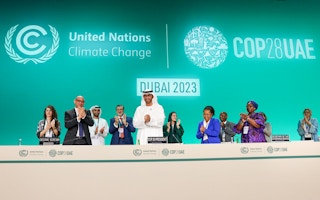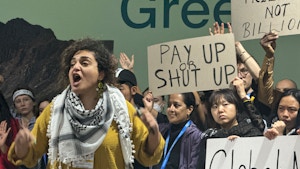The COP28 climate summit might have clinched an early victory last Thursday when countries agreed to a new fund for helping vulnerable nations cope with climate risks, but concerns still remain over the fund’s regulations and the decision to put the World Bank in charge of operating it, which some observers worry will end up benefiting rich donors.
To continue reading, subscribe to Eco‑Business.
There's something for everyone. We offer a range of subscription plans.
- Access our stories and receive our Insights Weekly newsletter with the free EB Member plan.
- Unlock unlimited access to our content and archive with EB Circle.
- Publish your content with EB Premium.
Delegates from the almost 200 countries attending the global COP28 climate talks in Dubai reached an agreement on setting up the loss and damage fund and got the summit off to a strong start – a surprise breakthrough given how negotiations over the past year has been intense, and on occasions bitter. At the summit, the announcement was received with loud applause and cheers.
The consensus was achieved partly as developing countries negotiators had relented and made a concession to withdraw its initial opposition against the World Bank’s role in running the fund, which was due to concerns over high costs, slow procedures and the United States’ influence on the institution. To get all countries on board, it was agreed the World Bank would serve as interim trustee and host of the fund for a four-year period.
Advocates for a rethink of the World Bank’s level of involvement had still hoped for improvements to the draft mandate of the loss and damage fund before it was agreed upon at COP28.
United Nations special rapporteur on climate change and human rights Ian Fry, who previously led climate negotiations for Tuvalu, one of the most climate-vulnerable island nations, expressed worries that the World Bank, as operator of the fund, has a board that is dominated by developed countries. This might give donor countries outsized influence over the fund, he said.
“
I believe the fund still has the potential to deliver climate justice if things continue to flow as they should. However, there is a long road ahead.
Ana Mulio Alvarez, researcher for loss and damage, E3G
“They can override decisions around the fund,” he told Eco-Business.
Fry also added that the World Bank’s processes for making funding requests are complicated. This could mean that countries that have the capacity to write lengthy submissions – often those in the developed world – get the money first; the rural poor and the Indigenous Peoples end up not having a voice in decision-making, he said.
Observers also fear that the interim arrangement for the World Bank to host the fund might become permanent. The fine print of the loss and damage fund says that if the multilateral performs well, a future COP can invite it to continue hosting the fund.
Senior campaigner for Swiss-based nonprofit Center for International Environment Law (CIEL)’s climate and energy programme Lien Vandamme said this will undermine the loss and damage fund’s ability “to meet the needs and priorities of those most affected”.
Vandamme agrees with the view that the World Bank is largely driven by the interests of wealthy nations. She said that it has a business model of providing loans rather than grants, and lacks critical modalities to ensure communities can directly access funds, or requirements that hold it accountable for adhering to human rights obligations.
She said that the World Bank’s involvement will perpetuate the avoidance by historic polluters of responsibility to pay for the loss and damage they have caused. This is a failure to “put the affected groups in the driver’s seat”, she added.
While the World Bank does disburse climate funds as loans, it also gives a lot of grants, argued a loss and damage researcher from London-based think tank E3G.
Under the loss and damage deal, one of the conditions the multilateral bank has to meet is to prioritise disbursing the climate funds as a grant or concessional loan, with low or no interest, Ana Mulio Alvarez told Eco-Business.
“The World Bank has yet to respond to any of the conditions, including disbursement modalities. But to be fair, the fund was just approved last week so it will take some time for them,” said Alvarez. “I believe they can accept the terms. Legally speaking, there is no reason why they can’t.”
Alvarez added that a key obstacle is instead the need to change the dynamics of how disbursement is processed within the bank, which could be challenging. If the bank does not accept the conditions then a new host would have to be found or the fund would have to be established as a stand-alone institution, she added.
“I believe the fund still has the potential to deliver climate justice if things continue to flow as they should. However, there is a long road ahead,” she said.
Eco-Business has reached out to the World Bank for comment on concerns over its role, but has yet to receive a reply. Speaking at a Financial Times event over the weekend, World Bank president Ajay Banga said the bank is not planning to be allocating loss and damage funding – a role reserved for the future governing board that includes officials from both donor and recipient countries.
However, the arrangements could change, pending ongoing conversations between countries, he said.
How the fund will work
More than US$650 million has been pledged to the new loss and damage fund for countries impacted by climate change since it was approved on Thursday.
Several countries had immediately committed donations into the fund – COP28 host United Arab Emirates (US$100 million), Germany (US$100 million), United Kingdom (US$50.7 million), United States (US$17.5 million) and Japan (US$10 million).
A host of other European countries, along with Canada, later also chipped in.
E3G’s Alvarez noted that the final approval of all of the arrangements will still be at COP29, so the money will not start flowing until 2025.
Previous studies have stated that billions of dollars a year is needed for developing countries to both protect themselves and recover from increasingly severe storms, floods and droughts.
At the same time, it is not immediately clear who is eligible to draw from the fund. The agreement specified that the money is for developing countries that are “particularly vulnerable to the adverse effects of climate change”.
While there is an existing but contested name list of developing countries, dating back to 1992, there is no formal indication which of them are particularly climate vulnerable.
But against growing climate risks, there are also those urging haste.
Sandeep Chamling Rai, a climate expert at WWF International, said the “immediate next step necessitates the establishment of the board for the loss and damage fund” under the World Bank.
“At this critical juncture, there is no time for mere discussions; it is time for decisive action,” he said.
While the operationalisation of the fund is a significant step toward supporting poor countries, an environmental group said countries must also focus on addressing the root cause of the climate crisis which is fossil fuels.
“Without a commitment to phase out fossil fuels this is an open chasm, more fossil fuels means more loss and damage. Unless high emitting nations also commit to a rapid phase-out of fossil fuels at COP28, the loss and damage fund will be blood money,” said Joseph Sikulu, Pacific director of advocacy group 350.org.














